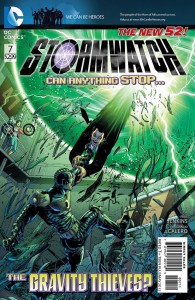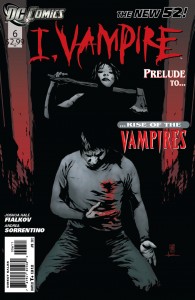 In reading Stormwatch #7, it occured to me that the best Stormwatch and Authority stories (and let’s face it: the New 52 Stormwatch is just The Authority with The Martian Manhunter) have been simple sci-fi and superhero comic tropes, only racked up on amphetamines and extrapolated out to their craziest violent extreme. Warren Ellis had them fight God. Mark Millar did great tales of the team fighting “The Avengers” (Sure, it was a pastiche of a famous superteam, but with personal and sexual problems… but up to a point, isn’t that all The Authority was?).
In reading Stormwatch #7, it occured to me that the best Stormwatch and Authority stories (and let’s face it: the New 52 Stormwatch is just The Authority with The Martian Manhunter) have been simple sci-fi and superhero comic tropes, only racked up on amphetamines and extrapolated out to their craziest violent extreme. Warren Ellis had them fight God. Mark Millar did great tales of the team fighting “The Avengers” (Sure, it was a pastiche of a famous superteam, but with personal and sexual problems… but up to a point, isn’t that all The Authority was?).
In this, writer Paul Jenkins, in his first issue on Stormwatch (First of two before Peter Milligan takes over), starts with an idea you could pull out of any Doc Savage story or early issue of Justice League of America – The Gravity Thieves! – and spins it out into a very dense-feeling, hard sci-fi(ish) story that, if not in league as the classic Ellis and Millar stories, at least it’s in the same ballpark, swinging for the fences.
The book hits pretty much every mark on the successful Authority story checklist. Weird sciency shit blowing people up in gruesome ways? Check; got that out of the way by the end of page two. Unknown, faceless entity demonstrating its power by taking out Big Gun Apollo? Yup; disembodied energy tentacles, to excite even the most darkly perverse hentai/tazer “enthusiast”. Find out that the threat is potentially extinction-level in nature to Earth? Hell, this one is capable of stealing gravity with their energy tentacles and wiping out all life in the known universe… possibly from being hit at high speed by hentai/tazer enthusiasts being flung through zero gravity in the opposite direction of their penises.









 Podcast RSS Feed
Podcast RSS Feed iTunes
iTunes Google Play
Google Play Stitcher
Stitcher TuneIn Radio
TuneIn Radio Android
Android Miro Media Player
Miro Media Player Comics Podcast Network
Comics Podcast Network